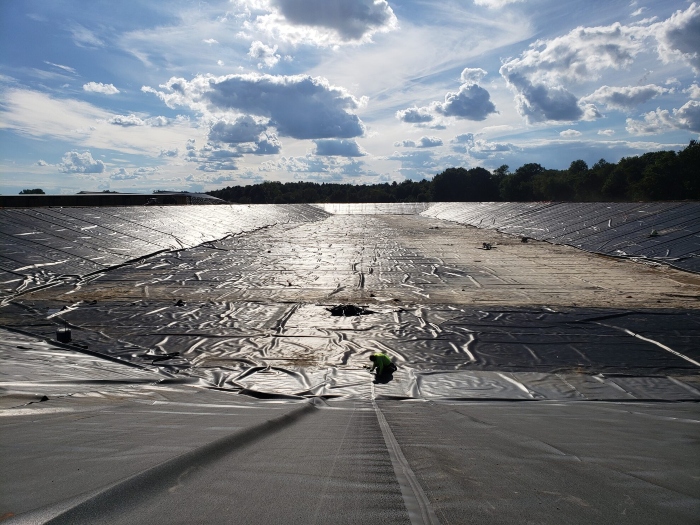LLDPE yield point
October 1st, 2023
Q: Can you tell me why my linear low-density polyethylene (LLDPE) is currently showing a yield point? In years past, we have not seen this happen. A: The yield point of HDPE is the first observation of zero slope measured on a stress-strain response curve. In most cases, this occurs between 12% and 19% […]
Understanding plastics: Single-use vs. engineering plastics
January 5th, 2023
For decades, the global production of plastics has grown yearly by an average of 9% (1). Plastic production was reported as 1.7 million metric tons in 1950 (2), and this value reached 360 million metric tons worldwide in 2018 (3). The MacArthur Foundation estimated plastic production to double again over the upcoming two decades (4). […]
IGS Webinar – An approach to high-density polyethylene (HDPE) geomembrane selection for challenging design requirements – October 25
October 21st, 2022
A webinar on An Approach To High-Density Polyethylene (HDPE) Geomembrane Selection For Challenging Design Requirements by Dr. Fady B. Abdelaal will take place on October 25, 2022 at 9 p.m. Eastern Time (U.S. and Canada). You can register here. An approach for selecting a high-density polyethylene (HDPE) geomembrane for a long design life is presented […]
Adding graphene to geosynthetics
June 1st, 2022
Q: I have some commercial application questions in the field of geosynthetics. We manufacture graphene powders in the most sustainable way, and it allows us to supply graphene to manufacturers much more economically. As you may have heard, graphene has wonderful material properties atomically to offer, and I am looking for opportunities to leverage its […]
New GSI method for strain hardening of HDPE geomembranes
April 1st, 2022
Traditionally, high-density polyethylene (HDPE) geomembranes are checked for stress crack resistance using the ASTM D5397 single point-notched constant tensile load (SP-NCTL) test (Hsuan, Lord and Koerner [1990]). This test uses notched specimens, surfactant, and elevated temperatures to accelerate the behavior and force a brittle failure in HDPE geomembranes. With today’s high stress crack resistant HDPE […]
Scratch impact on HDPE liners
April 1st, 2022
Q: I have a project where multiple and extensive scratches were created on the high-density polyethylene (HDPE) liner for a reservoir due to poor construction practices. (See the following Figures 2–4.) FIGURE 2 Construction equipment that caused scratches at crest of slope FIGURE 3 Overview of scratches in 60-mil (1.5-mm) high-density polyethylene (HDPE) conductive liner […]
Methane gas geomembrane permeability
April 1st, 2022
Q: What is the least permeable geomembrane to methane gas? Regarding the permeability of geomembranes to methane gas, could you send me some technical guidelines? A: High-density polyethylene (HDPE) geomembranes are denser (more crystalline) than linear low-density polyethylene (LLDPE) geomembranes and less permeable. The water vapor, solvent and methane transmission (diffusion) of an HDPE barrier […]
NSF 61-certified HDPE geomembranes
April 1st, 2022
Q: Hi, we are looking for options for NSF 61-certified high-density polyethylene (HDPE) liners for installation in a potable water tank, 95th-percentile concentration of free chlorine in the tank is 1.2 ppm (1.2 mg/L). The current liner (60-mil [1.5-mm] textured HDPE, installed in 1999) is damaged and needs to be repaired or replaced. We are […]
Welding HDPE geomembranes with biogas present
April 1st, 2022
Q: We are a Brazilian company specializing in biogas plants. We have built a big lagoon biodigester with a high-density polyethylene (HDPE) geomembrane cover. Now the cover is leaking liquid contained in the lagoon: We are organizing the repair procedure, and we would like to first investigate state-of-art practices and procedures for welding HDPE geomembranes […]
Geomembranes for agriculture protect environment
March 9th, 2022
Experts at International Cover Systems Inc. discuss two major applications of geomembranes for agriculture that protect the environment. FIGURE 1 Large geomembrane-lined agricultural lagoon before filling. Photograph courtesy of International Cover Systems Inc. Many of us love meat and dairy, but most put little thought into the waste produced by the animals that bring us these tiers […]
 TEXTILES.ORG
TEXTILES.ORG



